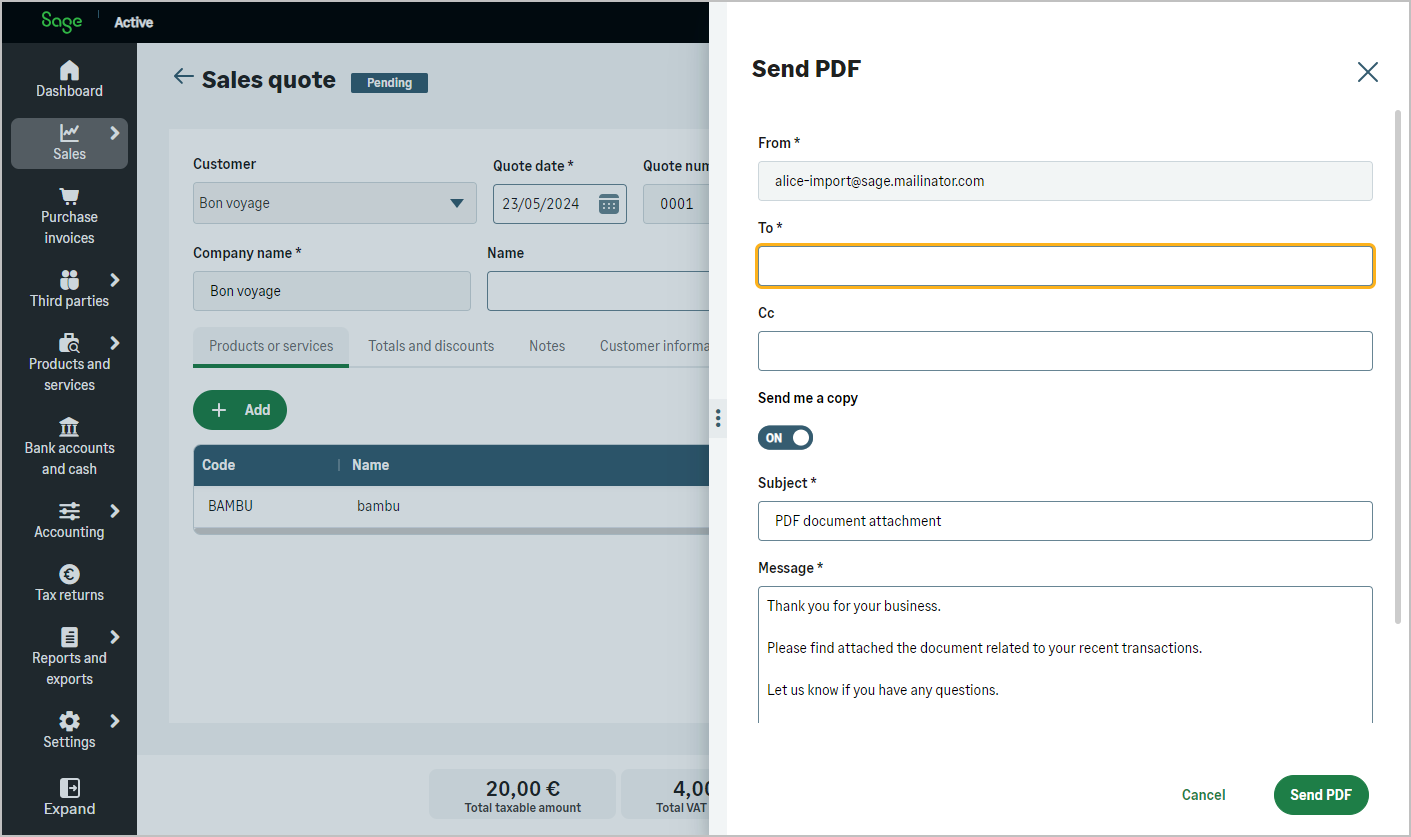This service automates the process of emailing PDF documents to specified recipients, including CC and BCC options.
DocumentPdfEmail
Quick Links
Accounts Accounting Entries Products Customers Sales quotes Sales invoices Suppliers Purchase invoices| HTTP | Operation | Type | Object | DTO Why-DTOs? |
|---|---|---|---|---|
| (Query) | documentPdfEmail |
DocumentPdfEmailGLDtoInput |
Description
The DocumentPdfEmail service allows you to send documents in PDF format via email directly from the API.

Functionality
- Email Sending: Automates sending of documents in PDF format.
- Supports Different Document Types: Able to send email for various document types such as sales quotes, orders, delivery notes, and invoices.
- Customizable Email Details: Allows setting of sender, subject, and body content for the emails.
Input Parameters
Document Details: Specify the details of the document to be emailed.
- type: Mandatory, type of the document for which the PDF is requested to be emailed. (a quote, an order, a delivery note, an invoice)
- id: Mandatory, the unique identifier of the document.
Email Addresses: Mandatory, specify the email addresses involved in sending the PDF.
- emailFrom: The email address of the currently logged-in user, from which the email will be sent.
- emailTo: The primary recipient’s email address.
- emailCc: Email addresses for CC recipients.
- sendEmailCopy: Boolean indicating whether to send a copy of the email to the sender.
Email Content: Mandatory, specify the content of the email.
- emailSubject: The subject of the email.
- emailMessage: The body content of the email, can be in HTML format. Notably, to manage line breaks use <br>.
Response
The service returns a DocumentPdfEmailOutputGLDto object containing the following fields:
- type: type of the document for which the PDF is requested to be emailed.
- id: the unique identifier of the document.
Header
| Key | Value |
|---|---|
Authorization |
Bearer Current access Token How to find? |
X-TenantId |
Current tenant id How to find? |
X-OrganizationId |
Current organization Id How to find? |
x-api-key |
Primary or secondary subscription key of your app How to find? |
How to use the DocumentPdfEmail service?
graphQL Query
query($input: DocumentPdfEmailGLDtoInput!) {
documentPdfEmail(input: $input) {
type
id
}
}
graphQL Variables
{
"input": {
"type": "SALES_INVOICE",
"id": "7af9f050-4a34-4a0b-a1af-30fe00a38abc",
"emailFrom": "[email protected]",
"emailTo": "[email protected]",
"emailCc": "[email protected]",
"sendEmailCopy": false,
"emailSubject": "PDF document attachment",
"emailMessage": "<b>Thank you</b> for your business.<br>Please find attached the document related to your recent transactions.<br>Let us know if you have any questions.<br>Kind regards"
}
}
Example Response
{
"data": {
"documentPdfEmail": {
"type": "SALES_INVOICE",
"id": "0e1987c3-1f23-4906-8b26-42e4a4c36079"
}
}
}
documentPdfEmail Input parameters
| Fields | Type | Description |
|---|---|---|
| type |
|
Type of the document (e.g., SALES_INVOICE) |
| id |
UUID | Unique identifier of the document |
| emailFrom |
String | Sender’s email address |
| emailTo |
String | Primary recipient’s email address |
| emailCc | String | CC recipient’s email addresses |
| sendEmailCopy | Boolean | Whether to send a copy to the sender |
| emailSubject | String | Subject of the email |
| emailMessage | String | Body content of the email |
Info
-
emailFrom: The email address of the currently logged-in user, from which the email will be sent.
This email can be retrieved from the userProfile under the field authenticationEmail. -
emailMessage: The text can be in HTML format. Notably, to manage line breaks use <br>
Sample
<b>Thank you</b> for your business.<br>Please find attached the document related to your recent transactions.<br>Let us know if you have any questions.<br>Kind regards
documentPdfEmail Response
| Fields | Type | Description |
|---|---|---|
| type |
|
Type of the document sent |
| id | UUID | Unique identifier of the document |